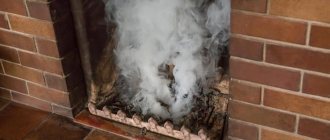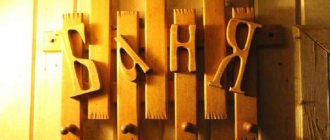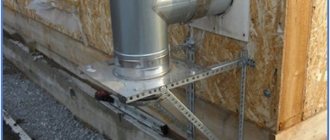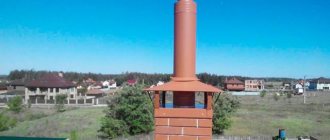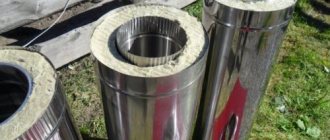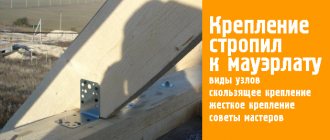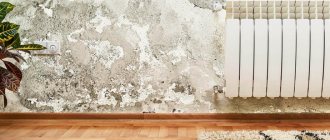Experienced summer residents, as well as owners of bathhouses and private houses with stove heating, know that regular chimney cleaning is a mandatory procedure and it is dangerous to neglect it. In this article I will try to talk in detail about how to clean a chimney in a stove in a private house in three ways. I will also explain the dangers of a clogged chimney and how to determine the degree of contamination.
Cleaning a chimney pipe yourself is real.
Causes of plaque on the chimney
Combustion waste accumulates in the chimney for various reasons. For example, one of the reasons may be the design of the chimney. If a direct-flow channel is provided for the exit of smoke, then soot and soot accumulate slowly in it, since the speed of passage of gases is high and deposits do not have time to hit the inner surface.
But such exhaust channels are rarely used; most often, chimneys are used in the form of a labyrinth , which are created to slow down the emission of smoke and greatly heat the walls of the chimney.
The efficiency of heating the room increases, but this design leads to a large deposition of soot on the walls of the chimney, and it is difficult to clean it due to the large number of turns. Chimneys of this type are equipped with special inspection hatches for cleaning soot.
Wrong fuel
It is known that in order for the stove to burn hot and provide warmth, the wood must be dry or have no more than 20% humidity. But this is not always the case in practice, which leads to incomplete combustion and particles entering the chimney, where they are deposited.
Resinous wood species produce a lot of deposits; sometimes wood that has been used and has acquired negative qualities is thrown into the oven. For example, old parquet that was removed from the floor to be replaced. They throw it into the firebox, not thinking about the fact that it is covered with resin and varnish.
Often the furnace vent is used to burn household waste. But if we are talking about cardboard and paper, then this is normal, which cannot be said about disposable tableware, plastic bottles, plastic bags and other similar human waste . When burned, chemicals release products that spoil the inside of the chimney, depositing on its walls.
Damage to masonry and poor quality material
The chimney can be made of brick, ceramics, metal and asbestos. The last two steadfastly resist decomposition from the effects of combustion products. The brick, despite the fact that it is fired, is gradually destroyed by the action of gases and acids.
This leads to the appearance of significant roughness on the inner walls . The smoke, passing through the smoke channel, gradually clings to irregularities, its speed decreases, therefore, the rapid release of combustion products does not occur.
When laying a chimney, stove makers try to lay the brick with the smooth side inward, but no matter how hard they try, the stove chimney gradually loses its smoothness . In addition, when laying, sometimes the standards for preparing the mortar are not followed, it dries out, the pipe cracks, which allows soot deposits to accumulate in the resulting irregularities.
Cracks are fire hazards; at high combustion temperatures in a furnace, hot gases and soot burning on the walls can fly out and cause a fire , for example, in floor or roofing materials.
Mechanical tools for removing clogs
This is an effective, inexpensive method in which a flexible metal rope with a heavy ball at the end is guided through a pipe. At a short distance from the core there is a special bristly brush that acts as a cleaner.
You can make a ruff with your own hands. The main difficulty is to find a well-centered ball that will not get stuck in the outlet channel, since this situation leads to disassembling the entire chimney. Making a brush from metal wires is easy.
When using a brush, safety precautions should be observed. With good draft, accumulated debris can fly out of the pipe and get into your face, so before cleaning you need to wear a protective mask and goggles. You should not make sudden movements so as not to fall from a height. It is better to secure yourself with a safety rope.
Sometimes, due to the inaccessibility of chimney cleaning from the roof, it is necessary to clean the system from below. If there is no glass for cleaning, you have to disassemble the beginning of the chimney.
Removing dirt from a metal furnace channel using a brush is not always high-quality, so instead of a bristle (iron) brush, it is better to wind it with a cloth winding, which will completely remove dirt.
How to find out about the need for chimney cleaning
If you do not clean the chimney, the roughness of the walls becomes greater, and the force of air friction on the side surfaces increases. The traction force is spent on overcoming this resistance and, as a result, the rate of release of combustion products decreases and the air consumption for heating decreases.
The temperature in the firebox drops and the house becomes cold . Instead of cleaning the channel, the owners of a private house begin to add fuel. All of the above reasons lead to a violation of traction, which is manifested in the following performance indicators:
- The amount of heat in the house remains constant, but more fuel is required to achieve this.
- Hot gases can cause soot in the pipe to ignite and lead to a fire.
- Burning soot emits black smoke visible from the chimney, and absolutely dry fuel can be loaded into the stove.
- The color of the flame turns into a dark red hue, which indicates a lack of fresh oxygen due to reduced draft.
The chimney in the house should be cleaned only if it removes solid fuel combustion . When gas fuel is burned in a chimney, other problems arise related to the formation of condensation.
The norm is to clean the chimney from soot once a year , this is done in any way at the beginning and end of the season, which prevents major cleaning or even disassembly of the chimney pipe.
Craft vase made of maple leaves
Another craft made from maple leaves for our competition, this time a vase. The work of Natalia Petrova.
"Hello! My name is Natalya, I am from the city of Kirishi. I work at a technical school as a psychologist. I have 2 children (1.5 g and 10 l). I am currently on maternity leave. My kids and I love to be creative whenever we have a free minute.
Now we offer you a master class on creating a vase from maple leaves.
We have to:
• Maple leaves,
1. Wipe the maple leaves.
2. Inflate the balloon.
3. Trim the stems of the maple leaves.
Good luck to you!
In order not to forget the page address and share with friends, add to your social networks:
More interesting:
What are the methods for cleaning a chimney?
To clean a chimney pipe, you can resort to several methods:
- folk remedies;
- use modern chemicals;
- ignite the chimney;
- mechanically remove soot deposits.
Using the first three methods, you can clean channels that have a slight degree of contamination. But if the walls of the chimney are overgrown with soot, then the mechanical method will be just right. The first two ways to clean the channel are to place a chemical or folk remedy and set it on fire.
Substances released during combustion actively decompose pollution. Some of the soot in the form of flakes escapes from the pipe and falls down onto the courtyard, the rest falls down to the channel bottom. Although calcining a chimney
Calcination is the burning of soot in a chimney due to the high combustion temperature. To do this, the furnace or boiler must be forced to operate at full power, which is ensured by supplying the greatest amount of oxygen. After heating, gases heated to a temperature of 600ºC cause soot to burn in the chimney and clean it.
The method requires a preliminary check of the integrity of the smoke channel , which can collapse over time; even simple rodents can make a contribution. Fire hazardous materials may ignite through openings.
Mechanical way to clean a chimney duct
This difficult task will become simple if you familiarize yourself with the information presented in this article. Before cleaning the stove, you should remove from the firebox all items that are poorly secured and may interfere. The stove and hob, if any, are covered with thick cellophane or cloth and secured with a weight.
You need to start cleaning the chimney from the bottom; for this, use special brushes and brooms . After freeing the accessible part of the pipe, clean the chimney from the roof side. To do this, you need to secure yourself with a mounting belt, and using a sinker, try to push or pull out the layers of soot in or out.
If a lot of debris and soot accumulates in front of the stove, you can get rid of it with a vacuum cleaner or a broom and dustpan. This type of work is usually performed by men, as it requires some effort.
Soot can be considered the main enemy of a chimney; it reduces draft and gradually destroys the pipe. If soot begins to burn, then not all channel materials can withstand such heat.
Chimney cleaning with potato peelings
To clean the oven in this way, it is melted, then potato peelings are placed on the fire. The peel is pre-dried so that it burns well in the oven. The cleanings are placed in a container the size of a bucket and kept for several days. After this cleaning is ready for use in the form of a cleanser.
During combustion, cleaning products release starch, which destroys soot upon contact with it. If the work is done correctly, then within a few days the soot will fall out of the chimney in pieces, falling into the firebox. To clean the chimney faster, you can use mechanical cleaning items.
Using salt to get rid of soot
This method is more suitable as a preventive method for removing soot deposits, which it is advisable to use constantly. Salt is poured in an amount depending on the size of the stove onto the hot fuel.
When burning, salt particles will react with oxygen molecules and destroy the soot in the pipe . The effectiveness of the measures taken depends on the choice of salt quality, but you can choose the right substance by trying this cleaning several times.
Cleaning equipment and rules
The stove chimney (chimney) is cleaned if the layer of soot and soot reaches a thickness of 2 mm. Sequence of work:
- before mechanical cleaning, it is necessary to close all openings in the house intended for cleaning; the open fireplace must be curtained with a damp cloth;
- cleaning can only be carried out if there is no wind or rain outside;
- When cleaning at height, be sure to use insurance;
- The fireplace is first cleaned from the inside (debris is removed);
- Before cleaning with a brush or a brush, the debris is pushed down with a stick.
Basic accessories:
- for a pipe with a round cross-section - a metal brush with a diameter 20% larger than the dimensions of the pipe;
- for a square pipe - a brush with metal bristles;
- scraper;
- for breaking through blockages - a metal core.
If the soot layer is too dense, then before using the brush it must be cleaned with a scraper. Only after this can you use a brush (or brush). The brush should move up and down in smooth movements. The brush should be equipped with holders that will connect when moving downwards. If a blockage is detected (garbage or fallen brick) that the brush does not allow through, you need to use a metal core with a diameter of 2/3 of the pipe cross-section, which is attached to a cable - throw it into the center of the structure, trying not to hit the walls, so as not to destroy the structure. In addition, the core can be used to weigh down a brush or brush. If your home has an open-frame fireplace connected to a straight pipe, it may be possible to clean it with a long-handled brush straight from the firebox. After cleaning the pipe, it is also necessary to clean all the windows for cleaning, the air vent, the door and the firebox itself.
Traditional recipes for burning soot
We can say with confidence that these means of cleaning channels for removing combustion products are dangerous and not every chimney can withstand this. Cracks appear in the walls of the chimney due to high temperature; sometimes it is better to use other means for cleaning.
Walnuts and aspen . Walnut shells have the amazing property of high heat transfer. Therefore, to clean the chimney, you need to place about two-liter jars of shells in the firebox. This product will make the rising smoke as hot as possible, which will burn the soot in the chimney.
Aspen was an accessible material in the northern and middle regions of Russia, so it was used quite widely. This method is one of the best for cleaning , but against the backdrop of modern chemicals it is undeservedly forgotten. When burning aspen logs, all stove valves and doors should be closed.
After combustion, white flakes begin to fly out of the chimney, which are a product of soot combustion. The stove will make a loud noise and the soot will burn out completely , but the cleaning method is dangerous for weak chimneys.
Chimney cleaning with mothballs
Before using this method, you must ensure the following:
- There are no cracks, damage or holes on the outside of the chimney; if any are found, they are carefully sealed with mortar and allowed to dry.
- Make sure that no objects or work items accumulate in the channel passage.
Naphthalene for small stoves in a private home is used in the amount of one tablet, which is thrown onto the burning fuel . Soot, as in the case of aspen, will fly out in white flakes.
Naphthalene is a substance with a crystalline structure with a sharp, characteristic odor; sometimes, when used as a chimney cleaner, it explodes, which can lead to destruction of the pipe and subsequent fire.
How to Skeleton Leaves
Leaf skeletons, due to their lightness and transparency, look very impressive as decoration. To achieve this effect, you need to resort to a special technique - skeletonization.
What you will need:
- any fresh leaves;
- soda;
- egg dye;
- small container - ladle or pan;
- Toothbrush;
- paper napkins.
Crafts from waste materials: original ideas
DIY salt dough figurines: instructions, photo ideas
How to make skeletonized leaves:
- Mix soda and water in proportions of 1 to 4 and place the leaves in the prepared solution so that they are completely hidden by water.
- Bring the mixture to a boil and leave to simmer for 30 minutes.
- Remove the pan from the stove and remove the leaves, carefully placing them on the table with the glossy side up.
- Remove excess moisture using napkins.
- Clean the pulp from the leaf with a brush (this must be done very carefully, the leaves are quite fragile).
- Rinse the skeleton under water and then paint it the desired color.
- Leave the painted skeletonized leaves to dry.
The resulting material is ready for use.
Cleaning if the pipe lumen is completely blocked
To do this, pour water (about three liters) into the chimney from above. After this, steam is released, which cleans the hole in the pipe. Soot flies out of the chimney in a compacted cloud of thick consistency. To prevent a chimney made of steel from rusting, they immediately begin to heat it and warm it up until the last moisture evaporates.
There are special cleaning logs or pellets , which are placed in the stove without opening the packaging, and the combustion lasts for about two hours. After this, the accumulation of soot and soot in the channel becomes loose, the separated light particles rise, and the heavy ones fall down into the firebox.
If special inspection holes are provided along the chimney, it is recommended to carry out preventive cleaning after using cleaning logs. There are special powders for cleaning the furnace outlet channel, for example, a Czech product called Kominichek, Smoke-Glas and others.
For their use instructions have been developed that will tell you how to use them correctly and what dosage to use. But all of them are used in the furnace to produce a chemical reaction, which results in substances that destroy the soot layer in the pipe.
In conclusion, it should be said that the smoke duct should be cleaned in any case, so that the misfortune of poor combustion of the stove is not added to the grief of sudden smoke in the room or a fire in the attic, where a pipe clogged with soot passes through.
Features of wood floors
Construction industry experts say that tiles do not combine well with wood flooring for the following reasons:
- wood responds subtly to changes in external factors - it expands at high humidity and dries out at low humidity. As a result, the tile covering may become cracked and peel off from the boards;
- wood quickly collapses and has low performance properties. After its destruction, the still usable tiles have to be dismantled;
- tiles laid with water-repellent adhesive prevent the penetration of oxygen into the floor, which is necessary for wood for long service life. All this leads to rapid deterioration of both the floor and the ceramics;
- wooden floors cannot withstand significant loads. The lightest tile for facing should be chosen.
Advice! It is allowed to begin tiling the wooden flooring only after 2 years have passed after the initial installation of the floor.
Thus, when laying tiles, at least 3 conditions must be met:
- ensure free circulation of oxygen and its access to the floorboards;
- distribute the planned loads evenly over the entire floor area;
- create a flat, strong base on top of the boards, which will ensure immobility and will firmly hold the tile.
Tips for preventing soot accumulation in the chimney
Just as it is better to prevent any health problems, it is better not to allow a very large accumulation of soot, which requires a large amount of time and effort to cleanse, at all.
This primarily concerns what material is used for the combustion chamber. You can reduce the amount of soot deposited on the walls inside by eliminating combustion in a furnace:
- Wet firewood (with a moisture content of more than 20%),
- Resinous materials from wood (oily combustion products contribute to very large deposits),
- Household waste (polyethylene bags, disposable tableware and other plastic
The problems of the initial poor design of the chimney can only be solved by dismantling and new masonry. Only professionalism at the stage of planning and manufacturing the stove will help to avoid problems during its subsequent operation.
Under the mesmerizing crackling of wood in the fireplace and the touch of spreading waves of heat, all the worries that are associated with maintaining the normal operation of this magnificent heating device are forgotten. Like any organism, even if it is not alive, it asks for constant care, rewarding it with trouble-free work. By adopting traditional methods for cleaning a chimney, you can save on purchased products and increase the time between manual cleanings.
Safety precautions
When cleaning a pipe from a roof, you should always remember the following safety precautions:
- You cannot work on the roof in rainy or windy weather;
- be sure to use insurance;
- in the absence of a safety system, you can tie a strong rope around your belt;
- Before work, it is prohibited to take any medications that may reduce the reaction rate. Drinking alcohol is strictly prohibited.
How to clean a chimney, video example:
Various animals can often live in a chimney pipe - birds like to make nests there, wasps build their honeycombs, etc. If it is possible to get a nest, then it is better to remove it through the top of the pipe. If it is deep, it is better to push it down
You should work with wasp nests carefully. If there is a colony of wasps living in it, then it is better to play it safe once again and wear a special beekeeper suit.
Chemicals to combat soot
To reduce the need for chimney sweep services, you can use chemicals to prevent the formation of soot - liquids, powders or briquettes that must be added to burning wood. All these means contribute to the destruction of the soot layer and its shedding down the walls of the chimney.
The most popular means:
- anti-carbon powder PHC - burned simultaneously with firewood, 150-120 g is enough for one ton of fuel;
- Kominichek cleaner is a product made in the Czech Republic and sold in the form of a package with five sachets weighing 14 g;
- chimney sweeper log - has the shape of a bar, when burned, substances are released that clean out carbon deposits along with the flow of combustion products exiting through the chimney;
- Cheerful Chimney Sweep powder contains resins that lower the temperature and help burn out carbon deposits; it is not a toxic product, which sets it apart from its competitors.
You can buy all of the above chemicals at any hardware supermarket.
Perhaps the most common remedy, according to consumer reviews, is Kominichek. Under the influence of Kominichek, a chemical process occurs that converts soot into oxide, which burns without flame at a low temperature.
According to the instructions, one bag is enough to clean a stove or fireplace; two bags are required for a wood-burning heating boiler. The bag should be thrown onto the burning wood without opening it and the firebox door should be closed. The dose cannot be increased.
If the soot layer is very thick, it is better to repeat the procedure. For prevention purposes, it is advisable to burn one sachet every two weeks. In addition to removing soot, this product increases the efficiency of wood-burning heating appliances and allows you to save money when purchasing fuel.
The second most popular means is the “Chimney Sweeper” log - a block (briquette), the combustion of which releases substances that affect soot deposits and contribute to their shedding down. The main purpose of this chemical cleaner is to prevent narrowing of the cross-section of chimneys due to soot and carbon deposits.
The “chimney sweeper” is suitable for use in any stove, fireplace, heater, stove, boiler. If the heating device is used daily, four logs will be required for a season (six months) (one briquette for two months). For a fireplace that is used only occasionally, one briquette per season is enough.
“Chimney sweeper” consists of sawdust, coal wax with coal dust, ammonium sulfate, urea, zinc chloride, sodium sulfate, silica and phosphorus oxide. This product is especially effective for brick chimneys.
Before using the Chimney Sweep for the first time, you must make sure that there are no loose bricks, debris, bottles or bird nests in the chimney. The most effective way to burn briquettes is on hot coals. Additives entering the pipe affect its inner surface for up to two weeks. All this time, soot falls into the firebox from above. After two weeks, it is advisable to clean the elbow and smoke damper.
What do buyers say about the log?
According to the official website, they show good performance and demonstrate high quality cleaning. Using the products does not require special skills. This makes the drug especially popular among buyers.
Homeowners who have already tried Chimney Sweep speak well of it. The tool copes with the assigned tasks and produces real results.
However, before starting the procedure, you need to carefully examine the chimney system and find out if there are any fatal damages in it. If there are any, they need to be eliminated urgently.
To avoid direct contact with the log structure during use, it is recommended to wear work gloves. They will reliably protect the skin of your hands from accidental contact with chemicals.The chemical log increases the soot burnout temperature to record levels. Under such intense heat, a damaged chimney may crack or begin to collapse.
The disadvantages of the drug include an unpleasant odor that remains in the room for a long time, and the inability of the product to remove large, old soot deposits.
Brush with weight
Chimney cleaning using various mechanical devices has been known for a long time. It is this method that is imprinted in the folklore of many European countries. Monuments to chimney sweeps can be found not only in the West, but even in Russia
Which once again speaks to the importance of their work. However, let’s not be distracted from the main goal, namely the answer to the question of how to clean a chimney.
For round pipes, a brush is best suited. This is a disc-shaped metal brush that is suspended from a cable or rope. A load is attached to the bottom of the brush - a core or a spherical weight. Other objects can also act as cargo.
But here it is important to remember that you should only use objects with a stable and undisplaced center of gravity. Otherwise, such a load may get stuck in the pipe and then the problem can only be solved by completely disassembling the chimney.
Under the influence of gravity, the brush falls down the pipe. A cable is used for lifting. The core itself (without the brush) can be used to break through dense clogs and plugs. Thanks to the carabiner connections, the brush elements can be quickly separated and assembled in the desired sequence
